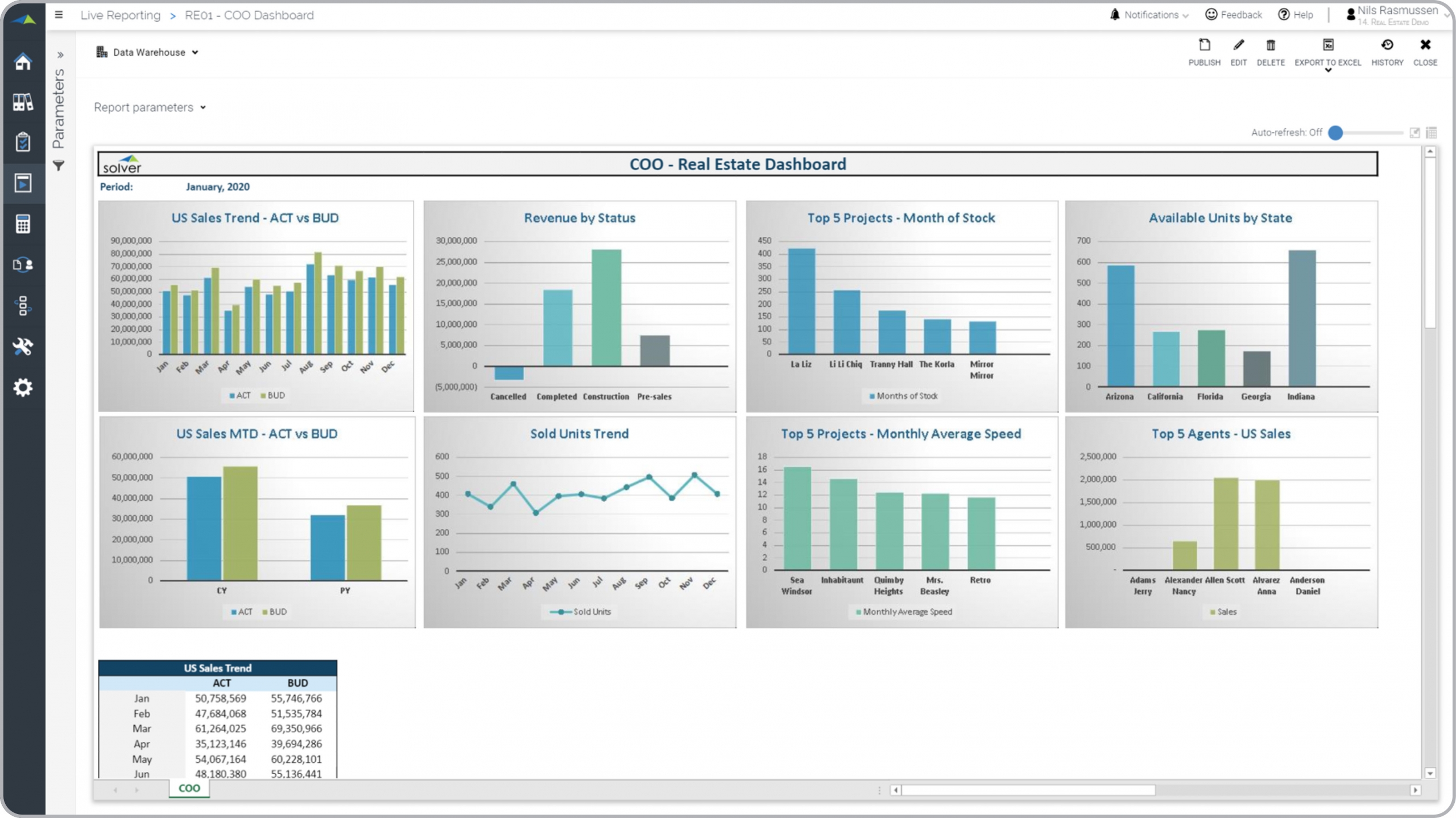Executive Dashboard for Real Estate Companies
What is an
Executive Dashboard for Real Estate Companies
? Executive dashboards are considered decision-support tools and are used by real estate leaders to analyze trends and budget variances for key corporate metrics. Some of the main functionality in this type of KPI report is that it provides eight different analytical perspectives, including: 1) Monthly sales trend with actual and budget comparison, 2) Comparison by status (e.g. cancelled, completed, construction, pre-sales) for real estate projects, 3) Top projects based on months of stock, 4) Available units by state/region, 5) Current year versus prior year sales with actual and budget comparison, 6) Monthly trend in sold units, 7) Top projects ranked by average speed, and 8) Top real estate agents ranked by sales. You find an example of this type of dashboard report below.
Purpose of
Executive Dashboards Real Estate companies use Executive Dashboards to enable easy anywhere, anytime analysis of top real estate metrics. When used as part of good business practices in Executive and Financial Planning and Analysis (FP&A) departments, a company can improve its strategic decisions and financial results, and it can reduce the chances that important tactics are delayed due to lack of real time reporting.
Example of an
Executive Dashboard Here is an example of an Executive Dashboard with monthly trends and actual to budget variances for various real estate KPIs. [caption id="" align="alignnone" width="2560"]
 Example of an Executive Dashboard for Real Estate Companies[/caption] You can find hundreds of additional examples
here
Who Uses This Type of
Dashboard report
? The typical users of this type of dashboard report are: Executives, project planners, financial analysts, budget managers.
Other Reports Often Used in Conjunction with
Executive Dashboards Progressive Executive and Financial Planning and Analysis (FP&A) departments sometimes use several different Executive Dashboards, along with budget and forecast models, sales reports, sales dashboards, profit & loss reports, balance sheets, cash flow statements, KPI dashboards, financial dashboards and other management and control tools.
Where Does the Data for Analysis Originate From? The Actual (historical transactions) data typically comes from enterprise resource planning (ERP) systems like: Microsoft Dynamics 365 (D365) Finance, Microsoft Dynamics 365 Business Central (D365 BC), Microsoft Dynamics AX, Microsoft Dynamics NAV, Microsoft Dynamics GP, Microsoft Dynamics SL, Sage Intacct, Sage 100, Sage 300, Sage 500, Sage X3, SAP Business One, SAP ByDesign, Acumatica, Netsuite and others. In analyses where budgets or forecasts are used, the planning data most often originates from in-house Excel spreadsheet models or from professional corporate performance management (CPM/EPM) solutions.
What Tools are Typically used for Reporting, Planning and Dashboards? Examples of business software used with the data and ERPs mentioned above are:
Example of an Executive Dashboard for Real Estate Companies[/caption] You can find hundreds of additional examples
here
Who Uses This Type of
Dashboard report
? The typical users of this type of dashboard report are: Executives, project planners, financial analysts, budget managers.
Other Reports Often Used in Conjunction with
Executive Dashboards Progressive Executive and Financial Planning and Analysis (FP&A) departments sometimes use several different Executive Dashboards, along with budget and forecast models, sales reports, sales dashboards, profit & loss reports, balance sheets, cash flow statements, KPI dashboards, financial dashboards and other management and control tools.
Where Does the Data for Analysis Originate From? The Actual (historical transactions) data typically comes from enterprise resource planning (ERP) systems like: Microsoft Dynamics 365 (D365) Finance, Microsoft Dynamics 365 Business Central (D365 BC), Microsoft Dynamics AX, Microsoft Dynamics NAV, Microsoft Dynamics GP, Microsoft Dynamics SL, Sage Intacct, Sage 100, Sage 300, Sage 500, Sage X3, SAP Business One, SAP ByDesign, Acumatica, Netsuite and others. In analyses where budgets or forecasts are used, the planning data most often originates from in-house Excel spreadsheet models or from professional corporate performance management (CPM/EPM) solutions.
What Tools are Typically used for Reporting, Planning and Dashboards? Examples of business software used with the data and ERPs mentioned above are:
- Native ERP report writers and query tools
- Spreadsheets (for example Microsoft Excel)
- Corporate Performance Management (CPM) tools (for example Solver)
- Dashboards (for example Microsoft Power BI and Tableau)
Corporate Performance Management (CPM) Cloud Solutions and More Examples
June 28, 2021
TAGS:
Reporting,
Solver,
report writer,
Microsoft,
template,
practice,
Acumatica,
Netsuite,
Finance,
planning,
GP,
dashboard,
executive dashboard,
Business Central,
excel,
ax,
forecast,
Budget,
Dynamics 365,
budgeting,
KPI,
Cloud,
Software,
Tableau,
SAP,
example,
best,
Sage,
BC,
D365,
agent,
NAV,
Intacct,
Real Estate,
project,
CPM,
report,
SL,
Management,
dynamics,
sales,
Power BI,
real estate dashboard

